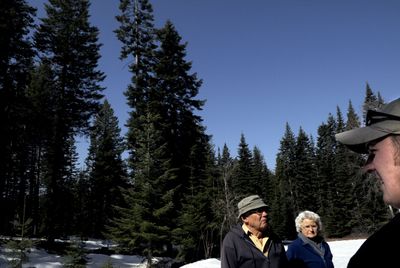Land trust helps families preserve forest property

A timbered parcel south of Silverwood Theme Park holds nearly seven decades of memories for Alan Robertson.
In the 1930s, his dad bought a quarter section of land near Ohio Match Road for a wood lot. The younger Robertson helped cut firewood on the property, which was sold to heat homes in Coeur d’Alene. As a teenager, he shot his first buck there.
Robertson, 76, and his wife, Marilyn, still visit the land regularly. Earlier this year, they worked with the Inland Northwest Land Trust to put a conservation easement on the property, ensuring that the 160 acres will always be a place for growing trees and sheltering wildlife.
“I don’t think people should be building on this type of property,” Alan Robertson said last week, as he hiked in the shade of 50-year-old fir trees, the regrowth from earlier harvests.
Aesthetics and wildlife habitat aside, the cost of fighting wildfires escalates when houses are built on the fringes of state and national forestland, said Robertson, a retired engineer who lives in Sandpoint.
Robertson and his wife own the land in partnership with Alan’s brother and sister-in-law in Texas. Their parcel borders 640 acres of forestland owned by the state of Idaho. It’s also near the Kaniksu National Forest.
The Robertson family will continue to selectively log the property, but the conservation easement prohibits future residential development. Deer, bear and moose tracks are often spotted on the property. Alan Robertson saw his first elk on the property this winter.
The Robertsons are typical of property owners who seek out conservation easements, said Chris DeForest, executive director of the Inland Northwest Land Trust, a nonprofit conservation group that has helped protect 8,500 acres since 1991.
“They have a family story on this land,” he said. “Alan has put a lot of work into his land. He knows every corner of it.”
Two years ago, the Inland Northwest Land Trust launched a program called Family Forests Forever to preserve unbroken tracts of private forestland in the Inland Northwest.
“So many people drive though North Idaho and think it’s all national forest,” said Kirk David, an assistant forestry educator at the University of Idaho’s extension office.
In actuality, 44 percent of the timberland in Idaho’s four northern counties is privately owned. Many are parcels in the hands of older landowners. The ownership patterns mirror national trends, which indicate that 25 percent of private forestland proprietors are 75 or older, DeForest said.
“We’re at the edge of a lot of land passing hands to the next generation,” he said. “People want to know: How do I keep this together for my kids?”
The trust is working with certified public accountants, financial planners and lawyers to tout the estate-planning benefits of conservation easements. Taking away the ability to develop residential lots lowers the value of private timberland.
“It reduces the value of the estate,” DeForest said, “and it can lower or eliminate estate taxes for heirs.”
Some property owners can also qualify for tax deductions by putting a conservation easement on their land. The deductions can be claimed over a period of years.
Robertson said he wanted to preserve his family’s legacy, as well as do right by the land. “There’s a bit of history here.”
His father, Clarence, worked as a brakeman on the Ohio Match Railroad, hauling logs out of the woods for processing at the company’s Huetter sawmill. Firewood cut from the 160 acres provided extra family income.
A logger, Charlie Carlson, lived a hermit-like existence on the land and ran a small mill operation for Robertson’s dad.
“He was an old bachelor – a Swede or a Norwegian,” Robertson said. “I remember hearing the saw going, and Charlie talking to himself. He was a rough, old woodcutter.”
Robertson hauls along a brush cutter when he visits the property, clearing openings for white pine seedlings. Marilyn Robertson, a bird watcher, keeps track of the avian population, which includes pileated woodpeckers and red-breasted nuthatches.
“We’re hoping for bluebirds. We brought along a house to put up,” she said.
In a generation or two, the white pine seedlings should grow into towering stands of trees. White pine once dominated the landscape, but the species was heavily logged in the early 1900s. The remaining trees were felled by an imported blister rust.
Robertson plants rust-resistant seedlings and hopes for the best.
“You can mess the land up in a hurry, but it takes a long time to restore it,” he said.